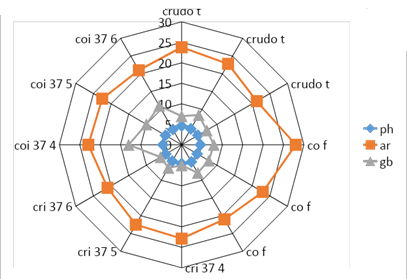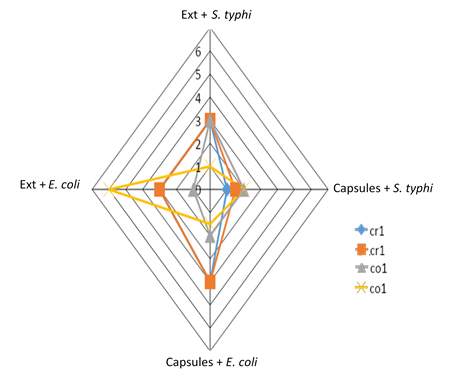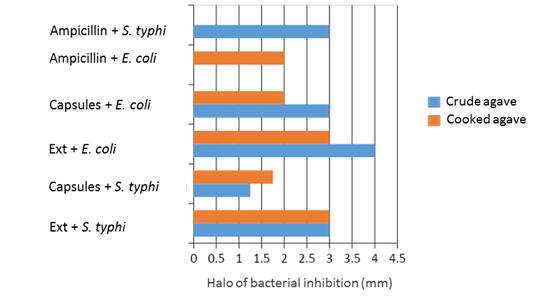Journal of
eISSN: 2572-8466


Research Article Volume 10 Issue 5
Universidad Autonoma de Guerrero, Mexico
Correspondence: Vargas Álvarez Dolores, Universidad Autonoma de Guerrero, Mexico
Received: July 04, 2023 | Published: October 24, 2023
Citation: Dolores VA, Valle-de la paz M, Ríos RR, et al. Agave cupreata fructans, encapsulation as pro and prebiotics. J Appl Biotechnol Bioeng. 2023;10(5):159-162. DOI: 10.15406/jabb.2023.10.00343
The agave or maguey belongs to the agaváceas family, with long and fibrous leaves, among this species is the Agave cupreata, endemic to the state of Guerrero, the agave has various properties, among them is the high content of fructooligosaccharides (FOS) derived from the hydrolysis of fructans. It has been shown that it possesses prebiotic properties, due to its β bonds it cannot be hydrolyzed by intestinal tract secretions. Therefore, they beneficially affect the host and stimulate the growth of lactic acid bacteria (LAB), which are colonizing the intestinal microbiota and preventing the proliferation of pathogenic bacteria. Therefore, the objective is to design a prebiotic and probiotic with agave fructans. With Bifidobacterium lactis Bb12 and L. acidophilus La5, encapsulate them and evaluate their antimicrobial effect against Escherichia coli and Salmonella typhi. Materials and methods: an extraction of agave juice was carried out in a 1:1 ratio between grams of sample and water, in crude and cooked agave, later it was inoculated and fermented with LAB for 4 days, it was decided to encapsulate to evaluate the antimicrobial effect. against Escherichia coli and Salmonella typhi. Results: the antibiogram indicated that E. coli is resistant to ampicillin, however the cooked and crude agave juice inhibited to E. coli, the same way cooked and crude agave juice, inhibited the growth of S. typhi, but it did not show resistance to antibiotic. Conclusion: the agave juice inoculated with (BAL) has an inhibitory action against Escherichia coli and Salmonella typhi.
Keywords: prebiotics, antimicrobial, fructans, agave
The Agave or maguey belongs to the families of the agaváceas, with long and fibrous leaves with a lanceolate shape, among this species is the Agave cupreata. The species of the Agave genus constitute the raw material for the production of traditionally used beverages with a high exchange value such as mezcal.1 The agave has various properties, among them is the high content of fructans such as inulin, levana and on the other hand those derived from the hydrolysis of these fructans, which are fructooligosaccharides (FOS).2 Fructooligosaccharides (FOS) are usually used as prebiotics. These have a complex structure with the presence of β (2 − 1) and β (2 − 6) bonds that give it prebiotic properties.3,4 When this polymer is ingested, due to the β bonds it contains, it cannot be hydrolyzed by intestinal tract secretions. Therefore it reaches the colon without undergoing any modification, it is here where the prebiotic is finally broken down and fermented by lactic acid bacteria (LAB) Bifidobacteria.5 Fructans are found in all tissues of the agave, including roots, rhizomes, and flowers, although they accumulate to higher levels in the large stem.6 Fructans from species of agave such A. salmiana improve the functionality of gut microbiota.7 Additionally, there is a peculiar subclass of FOS, the so called agavin fructooligosaccharides (aFOS), which are present only in Agave species.8 Agavins addition to dairy products has a great potential as functional ingredient in the manufacture of low-fat, prebiotics and symbiotic products.9 The prebiotic beneficially affects the host by stimulating bacterial growth and preventing the proliferation of pathogenic bacteria such as Shigella and Salmonella, as well as helping to strengthen the intestinal flora as it works as food for Lactic Acid Bacteria (bifidobacterium and lactobacillus). In people with flora affected by antibiotics, fructoolologosaccharides (FOS) help restoration by increasing beneficial intestinal flora from 20% to 70% while pathogenic bacteria decrease from 65% to 20%.10
For a better use and effect of both prebiotics and probiotics, it is decided to encapsulate them because it has been observed that their compounds are better preserved with encapsulation, without affecting their biological activity.11 Through encapsulation, bioactive substances (flavors, vitamins or essential oils) are introduced into a matrix, to protect them and do not suffer reactions due to light or oxygen, allowing longer storage time.12 Therefore, the general objective was: to design a prebiotic and a probiotic with fructans from Agave crupeata with lactic acid bacteria (LAB), Bifidobacterium lactis Bb12 and Lactobacillus acidophilus La5.
Sample collection
The collection of the Agave pineapple was carried out in the town of Mazatlan, collecting the Agave pineapple of approximately 6-8 years of age from approximately 3 different pineapple heads.
Sample extraction process
To obtain the extract, it was carried out by the method of hydrolysis and crude extraction, mechanically cutting the heart and the pineapple of the agave into pieces.
In a 1:1 ratio (grams of sample:water) it was hydrolyzed at 80°C for 60 minutes, then filtered on filter paper in 250mL flasks. For the cooked agave, the same procedure was carried out except for hydrolysis because the sugars were already hydrolyzed.
Determination of Brix degrees
To calculate the °brix, a refractometer was used, which determines the refractive index of a light beam, which crosses the medium in which the sugars are found. Brix degrees they are used to determine the total ratio of dry matter (usually sugars) dissolved in a liquid. A 25 °Bx solution contains 25 g of dissolved solid per 100 g of complete dissolution.
Determination of reducing sugars by the Lane-Eynon method
Reducing sugars have the ability to reduce alkaline solutions of copper, bismuth, or mercury. The most widely used metal for the determination of these sugars is copper. In 1848, Fehling found that the suitable reagents for this determination were copper sulfate (CuSO4) and alkaline tartrate (KNaC4H4O6H2O). The solution formed with these reagents is Fehling's solution. The elaboration of tables of the reducing capacity of Copper of the different sugars and the use of a 1% solution of Methylene Blue as an indicator of the end point of the reaction (Lane and Eynon modification). In this method, invert sugar reduces the copper in Fehling's solution to copper oxide (red). The sugar content in the sample is estimated by determining the volume of the unknown sugar solution required to completely reduce a given volume of Fehling's solution.
Inoculation and fermentation of agave juice with LAB
It was carried out for 4-5 days in both crude and cooked juices, adding one capsule of a consortium of Bifidobacterium lactis Bb12 and L. acidophilus La5, in a juice volume of 270 mL. A water seal was placed to create the anaerobic environment, since Bifidobacterium is a strict anaerobic bacterium. Subsequently, it was incubated in a water bath at 37 °C, until the determined time was fulfilled.
Encapsulation
In 50 mL of sodium alginate, 10 mL of agave sample was diluted until it formed a viscous consistency, with the help of a sterile pipette it was dropped onto the calcium chloride (CaCl) solution, capsules were formed, washed with sterile water and stored in refrigerated petri dishes.
Determination of the antibiogram
A disk antibiogram was performed, by the agar diffusion method according to Kirby Bauer, on a massive streak of E. coli and S. typi, on Muller Hilton agar plates placing the antibiotics. Using 10 µg ampicillin as control, 20 µL of a sample was taken by placing it on the sterile disk and a capsule of Bifidobacterium, L. casei and crude, and cooked agave juice on different plates, incubating at 37°C for 24 hours.
Beginning of the design of the prebiotic and probiotic from Agave
Juice extraction
The collected Agave samples were cut in small proportions to be crushed in a mechanical mill. Subsequently, the sample was weighed to add the water in a 1:1 ratio, both in crude and cooked agave, it was left to rest for 30 minutes to solubilize the sugars. Finally, the liquid extract was taken to physical separation, filtering and using filter paper in volumetric flasks (Figure 1).
Inoculation and fermentation were carried out for 4-5 days with Bifidobacterium lactis Bb12 and L. acidophilus La5 obtained from "Probiologi" probiotic capsules, added to the flasks with 270mL of agave juice, placing a stopper connected to a water seal to create an anaerobic environment. Since Bifidobacterium is a strict anaerobic bacterium, incubating in a water bath at 37°C (Figure 2). The encapsulation of the agave juice sample and Bifidobacterium, L. casei was performed with alginate and calcium chloride, obtaining crude and cooked agave juice capsules (Figure 3).
According to the determination of the antibiogram, it indicates that the discs with agave juice and the capsules present a halo of bacterial inhibition against pathogens such as E. coli and S. typhi. Whereas, E. coli shows resistance to ampicillin antibiotic (Figures 4 & 5).

Figure 4 The variation that exists in terms of pH (ph), °Brix (gb) and reducing sugars (ar), before and after being inoculated, is represented. Control crude (Crudo t); filtered cooked (co f); crude inoculated 37°C 4 days (cri 37 4); crude inoculated 37°C 5 days (cri 37 5); crude inoculated 37°C 6 days (cri 37 6); crude inoculated 37°C 4 days (coi 37 4); crude inoculated 37°C 5 days (coi 37 5); crude inoculated 37°C 6 days (coi 37 6).

Figure 5 Antimicrobial effect of agave juice and encapsulation against E. coli and S. typhi. Extract/juice (Ext); cr crude (cr); cooked (co). The results indicate that the juice had antimicrobial activity against E. coli and S. typhi.
The total reducing sugars, as well as the pH and °Brix were determined before and after inoculating the agave juice with Bifidobacterium lactis Bb12 and L. acidophilus La5, presenting a lower value in terms of sugars and °Brix after inoculation. , the pH does not vary much in the juice due to the presence of oxalic acid from the agave (Figure 5). An antibiogram was used to measure the antimicrobial activity of the Agave juice by impregnating filter paper discs with it and sodium alginate capsules with the juice placed on two crops: the first with E. coli and the other with S. typhi, Figure 6.

Figure 6 Antimicrobial effect of agave juice and capsules compared to the antibiotic against E. coli and S. typi. E. coli shows resistance to the antibiotic.
The blue bars indicate the degree of inhibition that the Agave juice and its capsules had, the results indicate that the Agave juice presents better inhibition than the antibiotic used (ampicillin) because the effect was much greater and harsher. Longer time unlike the antibiotic that later E. coli presented resistance to ampicillin, Figure 6.
Our values obtained according to the tests for total sugar content, Brix degrees and pH show a similarity (7-9) (Brix degrees reported in the study by Sánchez et al.,13 and data obtained in this work 7-8.5, this means that the Agaves have a similar sugar content in the same way their total sugar and pH values are similar, who reports values of 22.55±2% ATR in their total sugars and with a pH of 4.8 to 6. In the study carried out, values of 23±2% ATR were obtained, while for the pH they were 4-5. According to the results obtained, the bacteria inoculated in the agave juice presented biological activity, since during the fermentation time.
Studies have shown that the agave heart presented a lower concentration of simple sugars and a higher concentration of agave fructans, whereas the leaf base showed a higher concentration of simple sugars and fructooligosaccharides (FOSs), due to the synthesis of oligofructans occurs in the base of agave stems via the activity of the fructosyltransferase enzymes. In this case, the part of the plant used was the heart and pineapple of the agave, so it is important to consider expanding the study to the other parts of the plant such as the base of the leaf.14
Finally, the consortium of bacteria encapsulated with sodium alginate showed significant activity against pathogenic bacteria such as E. coli and S. typhi, despite the fact that E. coli presented resistance to the control antibiotic used, which in this case was Ampicillin. It is not known what achieved the inhibition since this work did not perform tests for the detection of metabolites that these bacteria secreted during fermentation in the juice, but according to the literature these lactic acid bacteria have the ability to synthesize bacteriocins. Which are substances that can affect the membranes of pathogenic bacteria causing them to disintegrate, thus achieving their inhibition.15
It has been observed, a clear lower content of glucose, fructose, and sucrose was observed in older specimens of Agave,16 due to at the degree of polymerization is related to function of the fructosyltransferase enzyme, whose activity varies as a function of the plant age;14 therefore, age it is important to consider the age of the agave plants used, and with this increase the amount of FOS and its biology effect. However, to must considered the type and concentration of simple carbohydrates and fructans vary depending on the species.17
According to the objectives, this was accomplished since the agave fructans were extracted by leaching and in the same way the juice was encapsulated with sodium alginate to preserve the properties of the juice in order to preserve bacterial survival. In this way, it was verified that Agave juice has antibacterial activity since it had an effect on pathogenic bacteria such as E. coli and S. typhi. With the use of these probiotics, the use of antibiotics can be replaced by natural products in those people who suffer from chronic gastrointestinal diseases due to these bacteria, especially in children.
None.
Authors declare that there is no conflict of interest.
There is no funding to report for this study.

©2023 Dolores, et al. This is an open access article distributed under the terms of the, which permits unrestricted use, distribution, and build upon your work non-commercially.